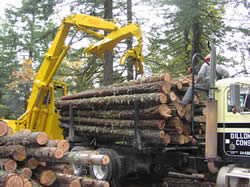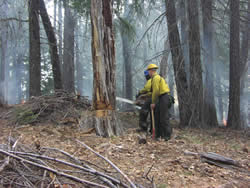
National Fire Plan Success Story
Mad Ridge Fuelbreak
Mad River Ranger District, Six Rivers National Forest
National Fire Plan - Fuels Reduction
2007

Small diameter material being removed for lumber / wood pellets

Felling a potential dead hazard tree.
Project Description
The Mad Ridge Fuelbreak is a hazardous fuel reduction project located on a ridgeline that bisects the Mad River Ranger District. The project area is approximately 30 miles long by 300 feet wide encompassing about 950 acres. The purpose of this project is to create a shaded fuelbreak in a strategically placed location that would protect four rural communities and provide safe access for wildfire suppression. Project activities included thinning conifers and hardwoods up to 12 inches DBH to an approximate 60 percent canopy closure as well as removing ladder fuels such as brush and saplings to achieve an increase in the crown base height and reduce fuel loading. Resultant hand piles are being burned, preparing the area for subsequent maintenance underburning.
The majority of the project planning and implementation was funded by the Trinity County Resource Advisory Council to protect "communities at risk" that were identified in the 2001 Federal Register.
Prior to implementation, the project area was mostly characterized by dense stands of Douglas-fir with an undergrowth of suppressed and intermediate conifers predominately located on north and east slopes. Much of the south and west slopes are occupied by oak woodlands that have been invaded by young Douglas-fir and manzanita in the absence of a natural fire regime. Post implementation is expected to yield more open stands of mature Douglas-fir and restore the oak areas to "pure" oak woodlands.
Implementation Plan and Accomplishments To Date
Implementation of fuelbreak construction began in 2004. To date, the entire fuelbreak has been thinned with the majority of the smaller material hand piled. Larger material was separated and made available to the public for firewood or sold as small sawtimber to be milled for lumber or utilized as wood pellets. Approximately 5 percent of the area was set aside for study or test treatments such as biomass removal, mastication, and piling with an excavator. Contract crews, the California Conservation Corps, and the Mad River Ranger District Fire personnel have accomplished the majority of hand piling. Hand pile burning is still in progress and expected to be completed by 2009, which will be followed by maintenance underburning.
Contact: Nancy Curran, Fuels Specialist, ncurran@fs.fed.us